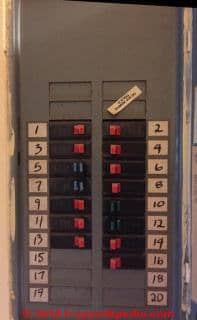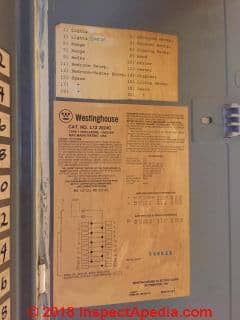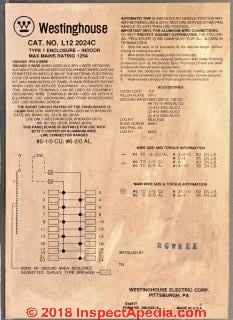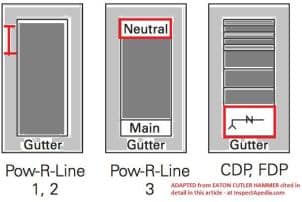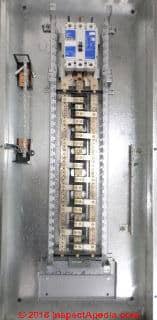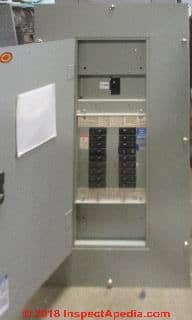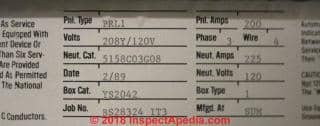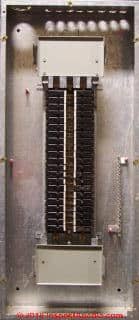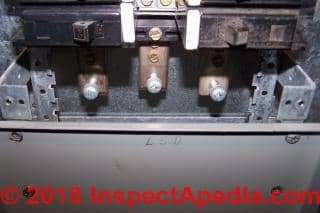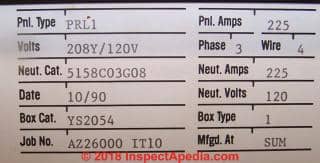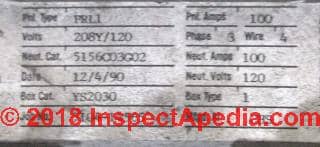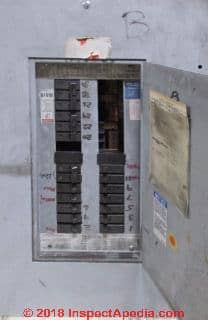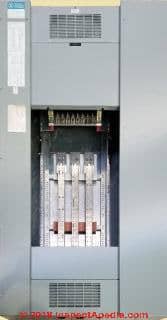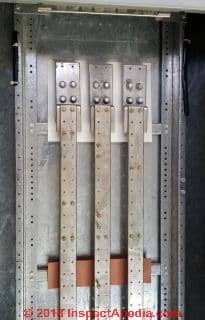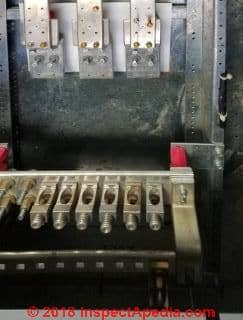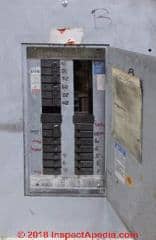 Identify Westinghouse Electrical Panels
Identify Westinghouse Electrical Panels
Westinghouse v. Bulldog Electrical Products
- POST a QUESTION or COMMENT about Westinghouse / Bulldog Pushmatic patent infringement lawsuit
History of Westinghouse Bulldog Electrical Panels - Patent Litigation.
Description of Westinghouse v. Bulldog Pushmatic circuit breaker patent infringement ligitation gives dates and history of these products,
InspectAPedia tolerates no conflicts of interest. We have no relationship with advertisers, products, or services discussed at this website.
- Daniel Friedman, Publisher/Editor/Author - See WHO ARE WE?
Identification of Westinghouse Electrical Panels
[Click to enlarge any image]
Above: a Westinghouse electrical panel from a 1989 home in Lahaina, Hawaii, USA. Discussed also in the FAQs section at the bottom of CHALLENGER ELECTRIC PANELS
Information to help identify older and contemporary Westinghouse Electrical Panels
- VINTAGE WESTINGHOUSE PANELBOARDS [PDF], Eaton Cutler Hammer Corporation, Eaton Corporation Electrical Sector 1111 Superior Avenue Cleveland, OH 44114 USAWebsite: www.eaton.com, retrieved 2018/06/10, original source: http://www.eaton.com/ecm/groups/public/@pub/@electrical/documents/content/rp01400002e.pdf
Eaton CH has produced the document cited above, as of Feb 2013, to help identify Westinghouse panels for which Eaton sells replacement components or "renewal parts".
The company gives four steps foir identifying Westinghouse electrical panels in sufficient detail to permit ordering of replacement parts. We excerrpt from those instructions (in the PDF file given above).
Procedure for identifying renewal parts in a Westinghouse electrical panel - what circuit breakers fit in a Westinghouse Electric Panel?
Photo: a Westinghouse Electrical Panel data label identifying the model as CAT. No. L12-2024AC. More panel specifications are given on this label including the circuit breaker types that can be used. Click to enlarge the image. This panel does not appear to be one of the series discussed by the Eaton Westinghouse panel identification procedure given below. "L12" does not appear in the document.
A licensed electrician can, however, remove the panel face to expose thje panel bus construction to compare the neutral bus locations given in the procedure below.
1. Identify the type of panelboard (PRL1, PRL2, PRL3, PRL1-LX, PRL3-LX, CPD, FDP) from the data found on the nameplate.
Critical information used to identify the specific Westinghouse electrical panel includes:
• Type of panelboard
• Ampere rating of the main
• Ampere rating of the neutral
• Voltage
• Type of service (phase/number of wires)
• General order number
2. Refer to the listing below [and in the PDF file given above] and turn to the proper section in this renewal parts data to identify standard parts and components.
Description and Page in the Eaton CH document given above:
PRL1 and PRL2 panelboards . . . . . . . . . . . 3
PRL3 panelboards . . . . . . . . . . . . . . . . . . . . 6
PRL1, 2, 3 special trims and enclosures . . 8
CDP/HCDP panelboards . . . . . . . . . . . . . .10
Branch circuit breaker selection . . . . . . . . .11
CDP panelboards . . . . . . . . . . . . . . . . . . . . 12
FDP panelboards . . . . . . . . . . . . . . . . . . . . 16
Panelboard trim locks . . . . . . . . . . . . . . . . .19
Replacement panelboard trim clamps . . . 19
3. This book identifies those replacement parts most frequently ordered and that are readily available from stock.
These parts can be ordered by style or catalog number to speed up processing and delivery.
4. In the event that the nameplate is missing, it may still be possible to identify the panel type by the location of the neutral bar.
Figure 1 below shows the position of the neutral in the panelboard
Note: to identify Bulldog Pushmatic electrical panels see this separate page: PUSHMATIC - BULLDOG PANELS
Photo Guide to Older Westinghouse Electrical Panels
Note: some of these electrical panel photographs are adapted from Westinghouse electrical panels for sale on eBay. We do not represent that these panels are safe nor appropriate to use in homes.
Westinghouse FD3040 40A main breaker electrical panel, obsolete
Shown below
Westinghouse PRL1 225A 120.208VAC Electrical Panel ID Photos
Shown below a 1989 Westinghouse PRL1 225Amp electrical panel
Westinghouse PRL1 225A 208VAC distribution panel, no mains
Below note the location of the neutral bus vis-a-vis the Eaton CH Westinghouse electrical panel instructions excerpted above in this article.
Panel label for the above PRL1 225A Westinghouse electrical box indicates a panel date of 10.1990
Westinghouse PRL1 100A 208/120VAC Electrical Panel ID Photos
Shown below is identifying information for a Westinghouse PRL1 100A electrical panel dated 12.4.1990
Below is the entire Westinghouse PRL1 100A panel front
Watch out: this electrical panel, observed for sale on eBay in 20187, appars to have flash burn carbon marks on the panel door. IF interior components of the panel overheated or burned this panel is unsafe to use. - Opinion of the editors.
Westinghouse Pow-R-Line C Electrical Panel PRL4F-800A 208/120VAC
Shown below, a Westinghouse Pow-R-Line PRL4 panelboard dated 3.15.1994
Below: bus assembly details for the Westinghouse electrical panel PRL4F-800A 208/120VAC
More label information for the Westinghouse PRL4F-800A 208/120VAC
History of Westinghouse Versus Bulldog Electrical Panels - Patent Litigation
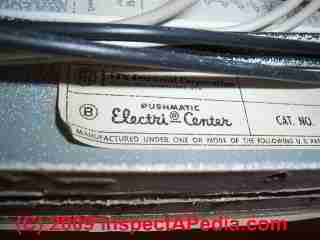 Westinghouse v. Bulldog Electric Products Corporation patent infringement litigation & product history
Westinghouse v. Bulldog Electric Products Corporation patent infringement litigation & product history
This is an appeal from a final judgment of the United States District Court for the Northern District of West Virginia, entered September 5, 1952, dismissing a complaint of Westinghouse for infringement by Bulldog of seven patents, six of which relate to electric circuit breakers and one to a circuit breaker panelboard.
Photos: a Bulldog Pushmatic Electri-Center electrical panel
206 F.2d 574 -- 98 U.S.P.Q. 300
WESTINGHOUSE ELECTRIC CORP.
v.
BULLDOG ELECTRIC PRODUCTS CO.
No. 6544.
Fourth Circuit.
Argued June 5, 1953.
Decided July 24, 1953.
Carl S. Lloyd, Chicago, Ill. (James M. Guiher, Clarksburg, W. Va. and Ralph H. Swingle, East Pittsburgh, Pa., on brief), for appellant.
Arthur W. Dickey and Jacob L. Keidan, Detroit, Mich. (C. Lee Spillers, Goodwin, Spillers & Mead, Wheeling, W. Va., S. Eugene Bychinsky, Butzel, Levin, Winston & Quint, Cyrus G. Minkler and Harness, Dickey & Pierce, Detroit, Mich., on brief), for appellee.
Before PARKER, Chief Judge, and SOPER and DOBIE, Circuit Judges.
DOBIE, Circuit Judge.
1 This is an appeal from a final judgment of the United States District Court for the Northern District of West Virginia, entered September 5, 1952, dismissing a complaint of Westinghouse for infringement by Bulldog of seven patents, six of which relate to electric circuit breakers and one to a circuit breaker panelboard. The complaint was in usual form charging infringement of the seven Westinghouse patents.
The answer denied validity and infringement of all of the patents in suit, set up an unclean hands defense, and as to one of the patents in suit, alleged a failure to disclaim certain claims of this patent which had been held to be invalid.
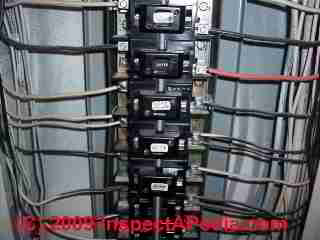 2 Four only of the seven patents sued upon are relied upon on this appeal, namely Jennings Reissue 19,887 (claims 1, 5, 6 and 9 only); Hodgkins 2,073,103 (claims 31, 32, 33 and 39-44); Jennings 2,190,517 (claims 15, 19-23, 25 and 27-35); and Swingle 2,339,362 (claims 27, 53, 54, 69, 70 and 76-80).
2 Four only of the seven patents sued upon are relied upon on this appeal, namely Jennings Reissue 19,887 (claims 1, 5, 6 and 9 only); Hodgkins 2,073,103 (claims 31, 32, 33 and 39-44); Jennings 2,190,517 (claims 15, 19-23, 25 and 27-35); and Swingle 2,339,362 (claims 27, 53, 54, 69, 70 and 76-80).
The questions involved are the validity and infringement of these patents. The elaborate opinion of the District Judge is reported in 106 F.Supp. 819.
3 The Defense of Unclean Hands or Misuse of Patents.
4 This case was before us once before on this issue, 4 Cir., 179 F.2d 139. The District Court had granted a summary judgment of dismissal on the ground that plaintiff had been guilty of illegally using the patents in suit in restraint of trade. We reversed this judgment and sent the case back to the District Court.
5 Bulldog stoutly insists that upon the evidence adduced at the instant trial, this defense is valid. We find nothing in the present record to support this contention, and it is not necessary to add to what was said by Judge Parker in his opinion on the former appeal.
The District Court held this defense to be unfounded.
6 Jennings Reissue Patent No. 19,887.
7 This patent covers a panelboard for electric circuit breakers. The Jennings panelboard uses a metal housing, comprising a bottom wall, side walls, and end walls forming a box-like structure. Fastened to the inside of the casing are longitudinally extending bars on which are mounted the circuit breakers in two rows.
8 The inner ends of the individual breaker enclosures each have a vent opening extending from adjacent the contacts into the space between the two rows of breakers.
This space id divided by a barrier into two separate flues or conduits which are closed by a cover plate. The gases formed by the arc drawn between the contacts adjacent the vent opening at the inner end of each circuit breaker escape into the conduit between the rows of breakers and are conducted to the upper end of the outer metal housing.
9 In panelboards having switches and fuses, there is no problem of safely dissipating arc gases given off during the interruption of short circuits. The switches do not interrupt short circuit currents, since that function is performed by the fuses; and the fuses are totally enclosed devices which are thrown away after each use and no gases are emitted therefrom.
One important problem in a circuit breaker panelboard is to get the arc gases, generated during the interruption of a short circuit, out of the space between the contacts without conductive particles being deposited on the walls adjacent the contacts, so that the device will maintain high dielectric strength and be able to operate successively, which is not required of fuses. At the same time, there must be no flashover between adjacent circuit breakers which are at different potentials.
10 The Circuit Master panelboard of Bulldog, the accused infringing device, consists of an outer metal box with a bottom and side walls. The two spaced rows of circuit breakers are mounted on channel bars.
Each circuit breaker is enclosed in its own housing comprising a base having a cover. Each breaker has an opening adjacent its inner end for venting the gases, formed when an arc is drawn between the contacts, into the space between the two rows of breakers.
This space is covered by a plate and thus forms a chimney. There is a plate at the upper end of the chimney which is provided with perforations, so that the gases may escape from the top of the chimney into the larger space within the metal box.
11 Prior patents in this field are Wesley, No. 926,372, O'Neill, No. 1,313,555, Burnham, No. 1,562,739, Starrett, No. 1,629,645, Greene, No. 1,741,839, and Baxter, No. 1,768,879. The record contains stipulated testimony which seems to establish prior public uses of panel boards containing circuit breakers in the Glassow residence in Minneapolis, Minnesota, and in the Pittsfield Building in Chicago, Illinois, in which central, side, top and bottom spaces are provided in the panel boxes between and around the circuit breakers in which air or gas could circulate.
12 The District Judge held (Conclusions of Law Nos. 2 and 4):
13 '2. None of the patents in suit are pioneer patents entitled to a wide range of equivalents; none of the devices shown in the drawings and described in the specifications thereof, except the Jennings Patent Re. 19,887, have had any material or substantial commercial success; all are improvements patents, and all are to be construed in the light of their respective specifications and drawings, and of the prior art, and limited substantially to the devices disclosed in their respective specifications and drawings.
14 '4. Jennings Patent Re. No. 19,887, claims 1, 4, 5, 6, 7 and 9, when construed in the light of the specification and drawings of the patent and in view of the prior art, are not infringed by defendant's Panelboard, Plaintiff's Exhibit 29.
15 'Claims 4 and 7 of this patent are invalid for want of invention in view of the prior art. Westinghouse Electric & Mfg. Co. v. Powerlite Switchboard Co., 6 Cir., 142 F.2d 965.
16 'Since plaintiff has entered no disclaimer of the claims 4 and 7 of Jennings Re. 19,887 held invalid in the prior suit, Westinghouse Electric & Mfg. Co. v. Powerlite Switchboard Co., supra, it has unreasonably neglected and delayed to file such a disclaimer, and in view thereof is not entitled to maintain this suit for infringement of claims 1, 5, 6, and 9, which were not adjudicated in said prior suit. 35 U.S.C.A. § 71, A. G. Triplett v. Lowell, 297 U.S. 638-649, 56 S.Ct. 645, 80 L.Ed. 949.' 106 F.Supp.at pages 870, 871.
17 There is, of course, nothing new about a panelboard of the general type covered in this patent. And, too, metal conduits for the transmission or release of gases are very, very old. We agree with the District Judge that this is in no sense a pioneer patent and that its claims and specifications must be narrowly construed and limited to the specific device therein disclosed.
18 As thus interpreted, the only important improvement disclosed by this patent is the construction of two special conduits, between the rows of circuit breakers, formed by the continuous barrier, for the escape of arc gases. While it may be conceded that this feature is an improvement over the prior art, we do not think it rises to the dignity of patentable invention. As a rather slender performance, it would seem to fall within the condemnation of the recent case of Great Atlantic & Pacific Tea Co. v. Supermarket Equipment Corporation, 340 U.S. 147, 71 S.Ct. 127, 95 L.Ed. 162. We, therefore, hold this patent invalid for lack of invention.
19 If this patent be valid under a narrow construction of its claims and specifications, we agree with the District Judge that it is not infringed by the Circuit Master panelboard, the accused device of Bulldog. This device does not contain either the continuous barrier or the two special conduits of Jennings thereby formed. On the contrary, Circuit Master uses (for the escape of arc gases) only the air circulation passages and spaces between the rows of circuit breakers, which were present and available in panelboards prior to the Jennings patent.
20 Our holdings set out above make it unnecessary for us to pass upon the defense set up by Bulldog, of the failure of Westinghouse to disclaim as to Claims 4 and 7 of this patent. The District Court held this a valid defense. In this connection, we are told, in the Westinghouse brief;
'This patent has now expired so only the question of liability for past infringement is involved. * * * The facts are that these claims were held invalid in June, 1944, in the Westinghouse v. Powerlite suit, 142 F.2d 965; but before this decision, the case at bar was filed (in November, 1943) so that there was no delay between the decision in the Powerlite case and the filing of this suit.'
21 Hodgkins Patent No. 2,073,103.
22 This patent for an automatic electric circuit breaker was asserted by Westinghouse against both Circuit Master and Pushmatic breakers, the accused infringing devices of Bulldog. Claims 31, 32, 33, 41 and 44 were asserted against Circuit Master, while claims 39-43 were asserted against Pushmatic.
23 We append the holdings of the District Judge as to this patent:
24 '6. The Hodgkins Patent No. 1,073,103, claims 31, 32, 33 and 44 are invalid in view of the prior patent to Krantz No. 1,726,233, dated August 27, 1929, if construed broadly enough to cover and include within their scope the defendant's Circuit Master circuit breaker.
25 'Hodgkins patent claims 39 through 43, inclusive, are invalid in view of the prior patent to Laganke No. 1,789,183, dated January 13, 1931, if construed broadly enough to cover and include within their scope either defendant's Pushmatic or Circuit Master breakers (claims 39-43, inclusive) are asserted against Pushmatic and claim 41 is also asserted against Circuit Master.
26 'None of the claims of said Hodgkins patent asserted to be infringed by defendant, when construed in the light of the specification and drawings of the patent and in view of the prior art are infringed by either of defendant's Circuit Master or Pushmatic circuit breakers.
27 'Hodgkins patent claims 39 through 43, inclusive, directed to the combination of a circuit breaker mechanism broadly stated and a casing providing a support and guide for the mechanism, are invalid for want of invention over the prior art represented by the prior patents to Weber No. 743,207, dated November 3, 1903, Aichele No. 1,732,295, dated October 22, 1929, DeReamer No. 1,494,221, dated May 13, 1924, Ellis No. 1,860,999, dated May 31, 1932, Gaynor No. 1,969,263, dated August 7, 1934, application filed October 30, 1929, Getchell No. 1,886,477, dated November 8, 1932, and Leganke No. 1,789,183, dated January 13, 1931. Great Atlantic & Pacific Tea Company v. Supermarket Equipment Corp., 340 U.S. 147, 71 S.Ct. 127, 95 L.Ed. 162; Cutler-Hammer Mfg. Co. v. Beaver Machine & Tool Co., 2 Cir., 5 F.2d 457, 461-462; Vapor Blast Mfg. Co. v. Pangborn Corp., 4 Cir., 186 F.2d 230, 235, 236.' 106 F.Supp.at pages 871-872.
28 The Hodgkins patent was involved in a previous suit, Westinghouse Electric & Mfg. Co. v. Frank Adam Electric Co., decision unreported, in the United States District Court for the Eastern District of Missouri, and was there held valid and infringed. However, the present record does not disclose the structure of the device accused of infringement in that case nor the considerations which led to the holding of validity and infringement, other than that certain prior United States patents are stated to have been before, and considered by, the District Court in that case.
29 This patent pertains to a somewhat compact and rather simplified type of circuit breaker, employing a floating lever by which the movable contact is carried. This lever is controlled by a bimetallic overload=responsive element, and is biased by a spring which moves the lever both upon manual and automatic opening operations. An insulating casing provides the frame, support and guide for the actuating means.
30 In the open position of the breaker, the 'floating lever' (i.e., one which has not fixed pivot), has one end latched to a bimetallic element and the other end in engagement with and actuated by a handle member having cam surfaces on the underside. The handle is in the form of a cap of insulating material, rotatable on the top of the casing.
The movable contact is slidably mounted in the casing for movement into and out of engagement with the fixed contact. The movable contact is carried by the floating lever. A spring, extending between a collar on the base and a flange on the member, tends to move this member and the contact to the open-circuit position. The pressure of this spring is thus exerted upon the lever at a point along a line of action between the two pivot points formed, respectively, by the latch at one end of the lever, and the point of engagement with the handle at the other end thereof.
31 Upon manual rotation of the cap or handle member in a counterclockwise direction, the cam moves the right-hand end of the lever downwardly about one pivot point, thus closing the contacts. When the handle is turned back to the starting position, the contacts are opened, with the floating lever pivoting about the same point. Thus the device may be used as a switch by manually rotating the handle.
32 When the contacts are closed, if an overload current heats the bimetallic element a certain amount, it will warp away from the end of lever, freeing the lever and permitting it to pivot about its right-hand end, under the pressure of the spring, to the tripped position, even though the handle may be held in closed position.
33 To reset the device after the bimetal has cooled, the handle is turned in a clockwise direction, whereupon the cam thereon moves the left-hand end of the floating lever downwardly to a position where a shoulder thereon engages the latch element, thus restoring the parts to the normal open position.
34 Here again we have , at best, a combination patent in a crowded field. All of the important elements in Hodgkins, performing substantially the same functions, may clearly be found in the prior art cited by the District Judge, especially Laganke, No. 1,789,183.
And particularly germane are the three cases cited by him in this connection. Indeed, all that Hodgkins accomplished was a rather clever arrangement of these elements which possessed some novelty. Manifestly, this patent must be precisely limited to that particular arrangement. As thus limited, all the claims in suit and their specifications fall far short of patentable invention. The Hodgkins patent must, therefore, be declared invalid.
35 The Multi-breaker of Westinghouse is claimed by appellant to have enjoyed considerable commercial success. We are convinced by the record that Multi-breaker bears only scant resemblance to the teachings of Hodgkins. It must more clearly resembles the Jackson patent, No. 2,096,546, which is owned by Square D Company and which is not in suit.
36 We agree with the District Judge that if, under a strict construction of its claims and specifications, the Hodgkins patent should be held valid, it is not infringed by Pushmatic and Circuit Master, the accused devices of Bulldog. Counsel for Westinghouse strongly stress in parallel columns of their brief the similarities between Hodgkins, on the one hand, and Pushmatic and Circuit Master on the other. Some of these similarities are inconsequential. Of many more it may truthfully be said that these same similarities may be observed when Hodgkins is compared with the prior art.
37 The structure of Hodgkins follows generally the form of the ordinary screw-type fuse plug. Stratton, witness for Westinghouse, appeared to admit that the precise train of mechanism set out in Hodgkins is essential to its operation. In neither Pushmatic nor Circuit Master do we find this same arrangment or this same train of mechanism.
Thus neither Pushmatic nor Circuit Master teach that the floating bar of Hodgkins must move relative to the handle and to the movable contact under all operating conditions, and must have releasable engagement with the bimetallic element.
Neither Pushmatic nor Circuit Master contains the block and spring of Hodgkins or an element thereto corresponding. The bimetals and the movable contacts, in Pushmatic and Circuit Master, are rigidly fixed to the switch arms. They therefore do not correspond to the floating bar of Hodgkins.
Nor are the switch arms of the accused devices operated by a separate and distinct mechanical element as in Hodgkins. The insulated breaker casing of Hodgkins is old in the art, and it is not used, and apparently could not be used, in the mechanisms of either Pushmatic or Circuit Master. We are also impressed, as was the District Judge, by the testimony of Professor Hoover, Bulldog's expert witness, to the effect that there is nothing in the drawings and specifications of the Hodgkins patent that would teach how to design or construct the Circuit Master or the Pushmatic.
38 Jennings Patent No. 2,190,517.
39 We append the holding of the District Judge on this patent:
40 '7. The Jennings Patent No. 2,190,517 claims 15, 19, 21, 27, 31 and 35 asserted to be infringed by Circuit Master only, claims 22, 25, 28, 29 and 30 asserted to be infringed by Pushmatic only, and claims 20, 23, 32 33 and 34 asserted to be infringed by both Circuit Master and Pushmatic, are invalid in view of prior patents to Laganke No. 2,025,872, dated December 31, 1935, Weber No. 743,207, dated November 3, 1903, DeReamer No. 1,494,221, dated May 13, 1924, Ellis No. 1,860,999, dated May 31, 1932, Gaynor No. 1,969,263, 1934, Aichele No. 1,732,295, dated October 22, 1929, and the prior invention of Christensen if construed broadly enough to cover and include within their scope the defendant's Circuit Master and Pushmatic circuit breakers.
41 'None of the claims of the Jennings Patent No. 2,190,517 above designated and asserted to be infringed by defendant's Circuit Master or Pushmatic or by both Circuit Master and Pushmatic, when construed in the light of the specification and drawings of the Jennings patent and in view of the prior art, are infringed by either of the defendant's Circuit Master or Pushmatic Circuit Breakers.
42 'All of the claims of the Jennings Patent No. 2,190,517 asserted to be infringed by defendant are directed to the combination of circuit breaker mechanism broadly stated and a casing having means for receiving the mechanism, and are invalid for want of invention over the prior art represented by the above designated prior patents to Weber, DeReamer, Ellis, Gaynor, Laganke, and Aichele.' 106 F.Supp.at page 872.
43 With these conclusions we agree.
44 This patent was held valid, but not infringed, in Westinghouse Electric & Manufacturing Co. v. Frank Adam Electric Co., decided by the United States District Court for the Eastern District of Missouri. The contention of Westinghouse that its commercially successful Quicklag breaker is made under this patent, seems, at best, only partially true. See also
45 This patent covers a low-cost breaker mechanism and a coacting two-part casing therefor of insulating material which forms the sole means for receiving and supporting the parts. This casing has a slot for slidably receiving through the open side of the casing a terminal which carries the stationary contact. After being slid into place in the casing, this terminal may be additionally secured by a screw.
46 The movable contact is on the contact arm and has a bimetallic element secured thereto for latching engagement with an actuating lever. The contact arm and actuating lever are mounted in the casing through the open side thereof on a pivot projection. The operating spring biases the contact arm toward open position.
47 A handle of insulating material moves on a part of the casing and, with a spring, actuates the movable contact. The arm, bimetallic element and flexible conductor, connecting the bimetal to a second terminal, are all fixedly secured together prior to mounting them in the casing. This provides a current path from the terminal to the movable contact without any relatively movable contacting surfaces across which current must flow.
48 Provision is made for slidably receiving the second terminal in the casing by means of a slot. The casing also has a projection for limiting movement of the contact arm to open position, and surfaces for limiting movement of the operating handle. In the closed position of the breaker, the operating spring reacts between the handle and operating lever, and holds the contacts in engagement through the latched bimetal element against the bias of the second operating spring. The breaker is manually opened by rotating the handle to cause the spring to move the lever toward open position. The spring then causes the contact arm to follow and carry the movable contact to open position. Reverse movement of the handle will manually close the breaker.
49 Upon the passage of overload currents through the breaker, the bimetal element releases the operating lever, permitting independent movement of the contact arm under the influence of its spring to automatically open the circuit entirely free of the handle. Afterward, the bimetal element may be reset by moving the handle in the reverse direction, and the circuit breaker is then closed manually in the manner previously described.
50 What has been previously said as to the Hodgkins patent seems even truer as to the Jennings patent. Here, again, we find in the prior art all the elements in Jennings, with these elements performing the same functions. This patent, too, is subsequent to Hodgkins and Jackson, No. 2,096,546. All that Jennings has done here is to devise a new arrangement of the old elements, which is, at best, a mere nonpatentable aggregation.
51 When, as must be the case, the claims and specifications of Jennings are strictly construed, they are not infringed by either Circuit Master or Pushmatic. It seems that against Circuit Master and Pushmatic none of the claims of Jennings which relate to the breaker mechanism alone are urged. The casing of the Jennings breaker, designed for the precise construction of that patent, is useless for the different mechanisms of both Circuit Master and Pushmatic.
52 The District Judge pointed out a number of differences between Jennings and Circuit Master and Pushmatic. Thus, in Circuit Master, we find no pins in the casing for slidably receiving the switch arm; this switch arm is mounted in, and carried by the handle; the handle is pivoted with a boss on each side. The housing of Circuit Master has no means for pivotally mounting the switch arm, or for supporting and defining the movement of the switch arm separately from the handle.
53 The construction and arrangement of the breaker mechanism in Pushmatic differs in many respects from Jennings. Pushmatic has no studs or pins in the casing for slidably receiving the switch arm or other similar parts. The parts of Pushmatic are laid, not slid, in assembly with the casing. Nor does the casing in Pushmatic, as in Jennings, individually support the contact or switch arm.
54 Swingle Patent No. 2,329,362.
55 This brings us to the last of the patents in suit. As to the Swingle patent, the District Court found:
56 '13. Swingle Patent No. 2,329,362, claims 27, 53, 54, 69, 70 and 76 through 80, inclusive, asserted to be infringed by defendant's Circuit Master circuit breaker must be construed to include two springs, one for manual operation to open and close the contacts and a second one to open the contacts on overload release, as essential to the operation of the circuit breakers described in the specification and disclosed in the drawings of the Swingle patent. If construed to require only one spring for both manual and overload operation, they are invalid for failure to describe an operable combination in the Swingle specification, and as claiming more than Swingle invented and disclosed. When construed to include the second overload opening spring essential to the operation of the circuit breakers shown and described in the Swingle specification, the claims are not infringed by defendant's substantially different Circuit Master which employs only one spring for both manual and overload operations and does not contain or employ the second spring for overload opening operation.
57 '14. The circuit breakers shown and described in the Swingle patent, being substantially different from and failing to suggest the construction of the defendant's Circuit Master accused of infringement, having had no commercial use, and the Circuit Master construction in its essential characteristics resembling that of the prior patent to Laganke No. 1,789,183 and not Swingle, all claims of the Swingle patent charged to be infringed are to be construed as limited to substantially the circuit breaker construction described in the specification and shown in the drawings of the patent, and so construed, they are not infringed by defendant's Circuit Master circuit breaker. * * *
58 '15. Considered in view of the prior art and especially prior patent to Laganke No. 1,789,183, dated January 13, 1931, which Circuit Master resembles in essential aspects of construction rather than Swingle, and prior patent to Krantz No. 1,726,233, dated October 27, 1929, which discloses all functions of the overcenter spring alleged to be novel in Swingle, and the fact that the circuit breakers described in the specification and disclosed in the drawings of the Swingle patent do not suggest the construction of Circuit Master and have attained no commercial use or importance, the Swingle Patent No. 2,329,362, claims 76 through 80, inclusive, written purposely in an attempt to cover the Circuit Master long after the Swingle application was filed and after plaintiff had learned of Circuit Master from defendant, are construed as limited substantially to the structures described in the specification and disclosed in the drawings of the Swingle patent and are not infringed by defendant's Circuit Master.' 106 F.Supp.at pages 873, 874.
59 In the Swingle patent, the movable contact is mounted directly and rigidly on an actuating lever, which is a floating lever because it has no fixed pivot. This lever has two pivot points and is actuated by a spring which achieves the following results:
60 1. Biasing the movable contact, operating handle, and floating lever to the open position;
61 2. Biasing the movable contact, operating handle, and floating member to the closed position;
62 3. Providing contact pressure when the contacts are closed; and
63 4. Biasing the floating member and movable contact to move to open position in response to release of the floating member by a bimetal latch. The end of this lever has a latch projection received in an opening provided in a bimetal element. For manual operation, a handle is pivotally mounted and is connected to the actuating lever by an overcenter spring.
64 During manual operation, movement of the handle moves the line of action of the overcenter spring across the pivot point where the end of actuating lever engages the bimetal. The overcenter spring alternately biases the floating lever and its movable contact to the closed position and to the open position upon movement of the operating handle, to effect manual opening and closing of the breaker with a snap action.
65 When the handle has been moved to closed position, the overcenter spring biases the handle, the floating lever, and movable contact to the closed position; and when the handle has been moved to its open position, the overcenter spring biases the handle, the floating lever, and the movable contact to the open position. The same spring at closed position provides pressure of the movable contact on the fixed contact.
66 The floating lever is guided during manual operation by movement of a pin on the lever in a guide slot in the frame. When the breaker is at its closed position, the overcenter spring also acts, upon release of the lever from the bimetal, to rotate the lever and its movable contact about the point of engagement of the pin with the lower end of the slot as a pivot, to separate the movable contact from the fixed contact and open the circuit in response to overload currents.
67 The Swingle patent shows an additional spring, the purpose of which is to increase the separation of the contacts on an automatic circuit-opening operation beyond that obtained by the overcenter spring. On manual circuit opening, the spring itself produces the maximum contact separation determined by the extent of the guide slot for the pin, because the line of action of the spring moves to a point well above the pivot point on the bimetal.
68 We think the Swingle patent falls in the same category with, and is subject to the same objections as, Hodgkins and Jennings. Once more we find in the prior art all the important elements of Swingle, all performing the same essential functions. The chronology and factual circumstances surrounding its grant seem to strengthen the view that Swingle discloses no more than a mere nonpatentable aggregation.
69 Swingle did not originate, and there is nothing new in automatic overload circuit breakers in which all operations are controlled by a single or identical pair of over-center springs, a so-called 'floating' switch arm operating about two pivot points, a circuit breaker having two main movable members, a handle, and a switch arm having a movable contact rigidly mounted upon it and operated by a single overcenter spring in both manual and overload operations.
70 If there be anything new in the additional spring of Swingle, which is dubious, this is at best a minor improvement, falling far below the dignity of patentable novelty.
71 On the question of whether Swingle was infringed by Circuit Master, the District Judge stated:
72 'In view of the fact that the Circuit Master construction and arrangement of parts is substantially different from that of the construction described in the specification and shown in the drawings of the Swingle patent which do not suggest the Circuit Master construction, the fact that the Circuit Master construction and arrangement of parts resembles that of the prior patent to Laganke No. 1,789,183 (not considered by the Patent Office in granting the Swingle Patent)
rather than Swingle, the fact does employ or contain the second spring for obtaining required opening of the breaker contacts on overload release, as do the circuit breakers described in the specification of the Swingle patent, the fact that Circuit Master does not employ a floating switch arm which has no fixed pivot point such as employed in the structures of the Swingle patent,
and the fact that in the Circuit Master construction the bimetal does not reasonably engage the switch arm and provide a pivot point therefor as in the Swingle constructions, all of the claims of the Swingle patent in suit, including those added for the purpose of attempting to cover the Circuit Master, must be limited in the respects mentioned to the structures disclosed in the Swingle specification, and as so limited,
do not cover and are not infringed by defendant's Circuit Master circuit breaker.' 106 F.Supp.at page 863.
73 With these conclusions we agree.
74 For the reasons stated, the judgment of the District Court, dismissing the plaintiff's complaint, is affirmed.
75 Affirmed.
...
Continue reading at BULLDOG PUSHMATIC DESIGN HISTORY or select a topic from the closely-related articles below, or see the complete ARTICLE INDEX.
Or see these
Recommended Articles
- CIRCUIT BREAKER FAILURE RATES
- CIRCUIT BREAKER LOCKS where we discuss circuit breaker locks for Pushmatic breakers.
- CIRCUIT BREAKERS RE-CONDITIONED USED
- ELECTRIC PANEL INSPECTION
- PUSHMATIC - BULLDOG PANELS
- BULLDOG PUSHMATIC BREAKER REPLACEMENTS
- BULLDOG PUSHMATIC DESIGN HISTORY
- PUSHMATIC BREAKER FAILURE REPORTS
- WESTINGHOUSE v. BULLDOG
Suggested citation for this web page
WESTINGHOUSE v. BULLDOG at InspectApedia.com - online encyclopedia of building & environmental inspection, testing, diagnosis, repair, & problem prevention advice.
Or see this
INDEX to RELATED ARTICLES: ARTICLE INDEX to ELECTRICAL INSPECTION & TESTING
Or use the SEARCH BOX found below to Ask a Question or Search InspectApedia
Ask a Question or Search InspectApedia
Try the search box just below, or if you prefer, post a question or comment in the Comments box below and we will respond promptly.
Search the InspectApedia website
Note: appearance of your Comment below may be delayed: if your comment contains an image, photograph, web link, or text that looks to the software as if it might be a web link, your posting will appear after it has been approved by a moderator. Apologies for the delay.
Only one image can be added per comment but you can post as many comments, and therefore images, as you like.
You will not receive a notification when a response to your question has been posted.
Please bookmark this page to make it easy for you to check back for our response.
IF above you see "Comment Form is loading comments..." then COMMENT BOX - countable.ca / bawkbox.com IS NOT WORKING.
In any case you are welcome to send an email directly to us at InspectApedia.com at editor@inspectApedia.com
We'll reply to you directly. Please help us help you by noting, in your email, the URL of the InspectApedia page where you wanted to comment.
Citations & References
In addition to any citations in the article above, a full list is available on request.
- Matthew Steger, CRI, WIN Home Inspection, 717-361-9467: msteger@wini.com
- Greg Bell, a Florida home inspector: http://www.bellinspection.com/files/Electric_panels.pdf at www.bellinspection.com Bell Inspection Service provides Inspection Services to Daytona Beach, Melbourne and Orlando Florida.
- http://www.selfhelpforums.com/archive/index.php/t-10032.html - conversation about Pushmatics, field failure report
- Patent infringement lawsuit: Westinghouse v Bulldog http://bulk.resource.org/courts.gov/c/F2/206/206.F2d.574.6544.html A copy of the court document is available here.
- Journal of Light Construction online help forum: http://forums.jlconline.com/forums/showthread.php?t=30720 - this article talks about home inspectors "playing it safe" by "failing" a Pushmatic panel - without supporting data.
- "Electrical System Inspection Basics," Richard C. Wolcott, ASHI 8th Annual Education Conference, Boston 1985.
- "Simplified Electrical Wiring," Sears, Roebuck and Co., 15705 (F5428) Rev. 4-77 1977 [Lots of sketches of older-type service panels.]
- "How to plan and install electric wiring for homes, farms, garages, shops," Montgomery Ward Co., 83-850.
- "Simplified Electrical Wiring," Sears, Roebuck and Co., 15705 (F5428) Rev. 4-77 1977 [Lots of sketches of older-type service panels.]
- "Home Wiring Inspection," Roswell W. Ard, Rodale's New Shelter, July/August, 1985 p. 35-40.
- "Evaluating Wiring in Older Minnesota Homes," Agricultural Extension Service, University of Minnesota, St. Paul, Minnesota 55108.
- "Electrical Systems," A Training Manual for Home Inspectors, Alfred L. Alk, American Society of Home Inspectors (ASHI), 1987, available from ASHI. [DF NOTE: I do NOT recommend this obsolete publication, though it was cited in the original Journal article as it contains unsafe inaccuracies]
- "Basic Housing Inspection," US DHEW, S352.75 U48, p.144, out of print, but is available in most state libraries.
- In addition to citations & references found in this article, see the research citations given at the end of the related articles found at our suggested
CONTINUE READING or RECOMMENDED ARTICLES.
- Carson, Dunlop & Associates Ltd., 120 Carlton Street Suite 407, Toronto ON M5A 4K2. Tel: (416) 964-9415 1-800-268-7070 Email: info@carsondunlop.com. Alan Carson is a past president of ASHI, the American Society of Home Inspectors.
Thanks to Alan Carson and Bob Dunlop, for permission for InspectAPedia to use text excerpts from The HOME REFERENCE BOOK - the Encyclopedia of Homes and to use illustrations from The ILLUSTRATED HOME .
Carson Dunlop Associates provides extensive home inspection education and report writing material. In gratitude we provide links to tsome Carson Dunlop Associates products and services.


